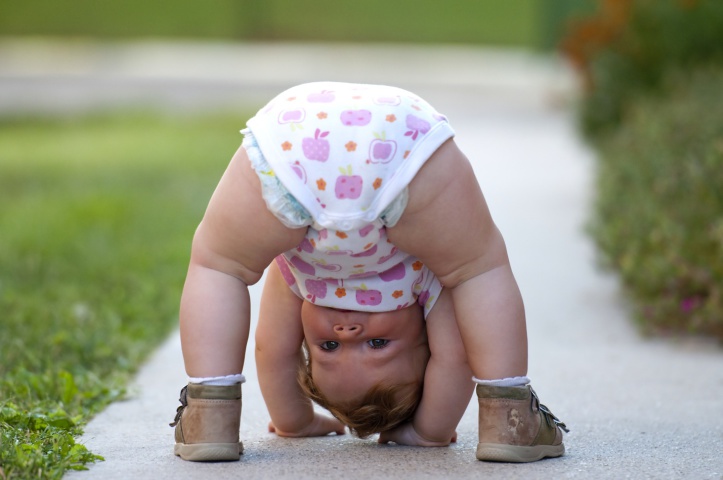
Plastics that make everyday life that much easier
Nice and dry bottoms
If you've ever changed a baby, you can't help but spare a thought for our grandmothers. Babies of that time were swaddled in large cotton cloth that was neither particularly absorbent nor particularly waterproof, and washing machines were still rare. Take a close look at a disposable diaper and you'll notice that it's formed from an intricate mix of technologies. The choice of components and the methods of assembly of the various parts indicate that nothing was left to chance and that it took the work of many engineers to come to the final result.
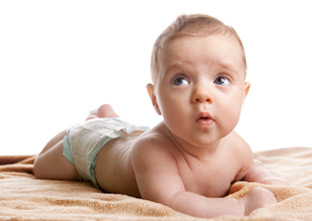
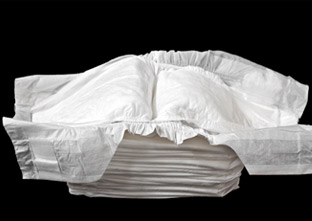
A disposable diaper is comprised of four distinct parts: the absorbent pad, the surface web, the outer envelope and the fastening system. Each part performs a specific and well-defined task. First of all, the absorbent pad: This is the heart of the diaper, the part that enables it to fulfill its function. It has to be of the highest quality because it needs to be soft and keep the baby's bottom dry for as long as possible. Cellulose fibres extracted from wood were used for a long time, but they have now been replaced by superabsorbent polymers. Polyelectrolytes such as sodium polyacrylate have the power to transform liquids into a kind of gel. Another advantage is that they are not irritable for the skin or the mucous membranes, and the potential for irritation is low. Each "superabsorbent" layer contains around fifteen grams of these polyelectrolytes.

The surface web is in contact with the infant's skin, and it consists of a textile manufactured from polypropylene fibres. It transfers urine to the absorbent pad while minimizing the amount of moisture in contact with the baby's bottom. It is this layer which guarantees a smooth skin for the baby. Then comes the envelope, where polymers once again reign supreme since it must be perfectly air- and water-tight while allowing enough air through to ventilate the child's bottom. And to further complicate matters, a whole series of elastics is added to hold the diaper in place without restricting the baby's movements, as well as a fastening system (sticky or otherwise) made of adhesive or velcro.
Bottles: more innovations !
Have plastic bottles gone the way of the Dodo? Certainly not! They are in fact as present as ever, and particularly now that polycarbonates have been replaced by the well-known polymer, polypropylene. Although plastics can be moulded to any shape, most discoveries and innovations are happening in the field of teats; there is a good reason for this, as a good teat must drain liquids at a perfect speed. Too fast and the baby could choke; too slow and the baby will have to strain to feed himself and therefore risk tiring himself out. Its shape was specially designed so that the baby can control the flow as it would in suckling its mother. It may not seem like much, but manufacturers had to spend hours observing babies during feedings to reach such a result. And because it is easily mouldable and rigid enough to regain its original shape, silicone is increasingly being used and is gradually replacing latex.
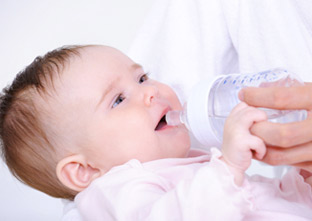
Another advantage of this material is that it is very neutral as it is both tasteless and odourless. And its transparency makes it easy to check cleanliness after washing.
![]() Silicone, a resolutely high-tech material, is now being used in the manufacture of the bodies of certain bottles. Is this a new fad? There is no evidence to support this affirmation because thanks to silicone, this latest generation of bottle comes with a flexible wall which allows the baby or mother to exert light pressure to force the milk through the teat. Now the flow can be controlled by a fingertip's press!
Silicone, a resolutely high-tech material, is now being used in the manufacture of the bodies of certain bottles. Is this a new fad? There is no evidence to support this affirmation because thanks to silicone, this latest generation of bottle comes with a flexible wall which allows the baby or mother to exert light pressure to force the milk through the teat. Now the flow can be controlled by a fingertip's press!
Breast pump/bottle: a successful alliance
 Some mothers choose to breastfeed their babies. Theoretically, bottles are of no use to them. Only theoretically, though, as the production of breast milk does not happen regularly; in fact, it often happens when baby is sleeping or not hungry. Fortunately, there are such things as breast pumps, which are a type of pump connected to a bottle. Once the milk has been extracted, it can be directly stored in the refrigerator, awaiting to be reheated. It's all so simple, and yet this ordinary everyday object used by many young mothers has also been the subject of numerous studies. It has been proven that a mother will draw her milk in greater quantity if she is relaxed and comfortably seated. Pumps must therefore be ergonomic, comfortable and efficient. Plastics, with their ability to take on any shape, are already part of the way there. All that remains to be done is to make them comfortable. Again, the solution was found through silicone, whose softness on the skin remains incomparable.
Some mothers choose to breastfeed their babies. Theoretically, bottles are of no use to them. Only theoretically, though, as the production of breast milk does not happen regularly; in fact, it often happens when baby is sleeping or not hungry. Fortunately, there are such things as breast pumps, which are a type of pump connected to a bottle. Once the milk has been extracted, it can be directly stored in the refrigerator, awaiting to be reheated. It's all so simple, and yet this ordinary everyday object used by many young mothers has also been the subject of numerous studies. It has been proven that a mother will draw her milk in greater quantity if she is relaxed and comfortably seated. Pumps must therefore be ergonomic, comfortable and efficient. Plastics, with their ability to take on any shape, are already part of the way there. All that remains to be done is to make them comfortable. Again, the solution was found through silicone, whose softness on the skin remains incomparable.
Bottle manufacturers also offer mothers who breastfeed a variety of accessories ranging from nursing pillows filled with superabsorbent and silicone shells that protect the often sore nipples. Although these accessories are in no way essential, they do help make life easier for mothers.
A plethora of accessories
Dozens of new objects will gradually find their way into the house, all for the baby's well-being. This can be a significant investment for parents! They often want what is best for their child while keeping an eye on their wallets. Let's face it: without plastics, young parents' expenses would reach astronomical heights. Plastics have enabled large-scale manufacturing of essential accessories, making them accessible to young parents. But that is not their only advantage; quite the opposite in fact, as these modern materials are much simpler to maintain, more durable and often much more "cosy". Mattresses for changing tables, bathtubs, pots, seats, play mats...the list goes on! The latest trend: baby pyjamas that are gradually being lined with soft synthetic fibres which dry in only a few hours after being washed.

A throne for the child king

There is still one area where opinions are divided - car seats. A closer look at the forums of websites dedicated to young mothers reveals page after page of opinions on this model or that. This is proof of many parents' interest in the safety of their offspring. Manufacturers are constantly looking for ways of improving safety and comfort in this buoyant market; and innovations abound in this particular area.
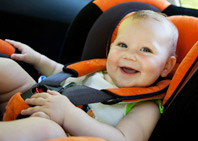 A car seat is, first, a plastic shell, often made from ABS, a rigid material with very good shock-resistant properties. These seats, much like the cars themselves, undergo batteries of tests and should, at least in Europe, meet stringent standards. As for the covering, it must fulfil two major roles: it must guarantee the best possible comfort and partially absorb shocks in case of an accident. Polystyrene and polyurethane foam ensure that the baby will be snugly seated in his throne, where he can finish off his sleep while his parents know that he is safe. Snug is the operative word, because in order for the seat to fulfil its safety function, the child must be properly maintained without feeling cramped. These two requirements seem to delight manufacturers as they seem to take great pleasure in constantly offering new models.
A car seat is, first, a plastic shell, often made from ABS, a rigid material with very good shock-resistant properties. These seats, much like the cars themselves, undergo batteries of tests and should, at least in Europe, meet stringent standards. As for the covering, it must fulfil two major roles: it must guarantee the best possible comfort and partially absorb shocks in case of an accident. Polystyrene and polyurethane foam ensure that the baby will be snugly seated in his throne, where he can finish off his sleep while his parents know that he is safe. Snug is the operative word, because in order for the seat to fulfil its safety function, the child must be properly maintained without feeling cramped. These two requirements seem to delight manufacturers as they seem to take great pleasure in constantly offering new models.
Britax, for instance, invented the D-Sip© system: a D-shaped plastic ring which fits around the seat. In the event of an impact, the door will initially hit the ring, which will distribute the energy of the impact throughout the shell of the seat, thereby protecting the child's head.
Like a racing driver
What is the secret to making a good seat? It is quite simple: the seat must be secured to the vehicle, and the child must be secured to the seat. Hence the importance of the harness which, upon closer examination, closely resembles those used by Formula 1 drivers. They are also designed following the same principles: a braided nylon fibre and a 5-point anchoring system. The latter gets a lot of attention because it is required by regulations on the subject; it must be strong enough to keep the child in the seat while remaining easy enough to open in the event of an emergency evacuation. What an oxymoron!
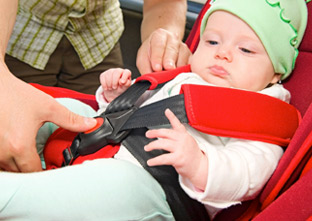

The manufacturer Kiddy did away with seatbelts and developed a kind of soft plastic shield able to hold the child and to absorb shocks. This innovative system, christened the impact shield, consists of high performance polymers whose honeycomb structure is designed to collapse by absorbing energy upon impact. The risk of dangerous injuries of the cervical spine is thus significantly reduced as the forces released during the collision are directed to the impact shield, preventing the child's head from suddenly being thrown forward or backward. This shield, which has successfully passed all tests, is particularly successful because it is much simpler to implement than traditional seatbelts.
Automatic air conditioning

This is another new development: manufacturers are working hard on - to improve the comfort of their seats, namely during periods of extreme heat or cold. This is how nanotechnology has been incorporated into the textiles for baby seats. Outlast developed a new, so-called, phase-changing material which can absorb, store and release heat in order to achieve an optimal management of moisture and temperature. These new polymers, whose secret is well-kept, are encapsulated in a plastic envelope and then placed directly on the fabric. So, if skin temperature is too high, the heat is absorbed; and if skin temperature decreases, the stored heat is transferred back to the skin. Basically, the baby produces his own air conditioning!





